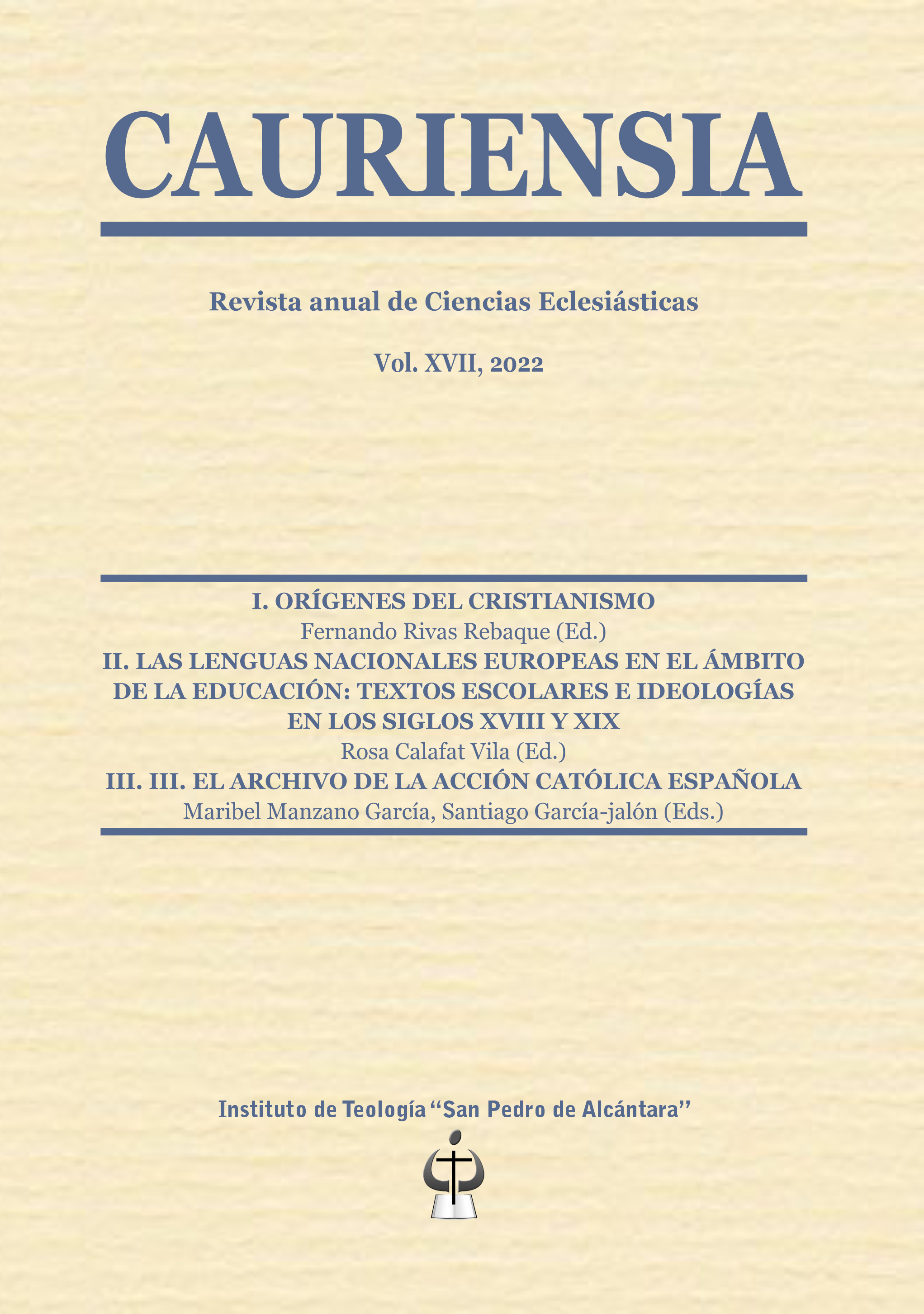Esclavitud y cambio de estatus en el cuarto evangelio. Una propuesta de lectura
Contenido principal del artículo
Resumen
Descargas
Detalles del artículo

Esta obra está bajo una licencia internacional Creative Commons Atribución 4.0.
Está permitida la reutilización del contenido bajo una licencia:
![]()
Reconocimiento
CC BY
Esta licencia permite a otros distribuir, mezclar, ajustar y construir a partir de su obra, incluso con fines comerciales, siempre que le sea reconocida la autoría de la creación original. Esta es la licencia más servicial de las ofrecidas. Recomendada para una máxima difusión y utilización de los materiales sujetos a la licencia.
Citas
Barclay, John M. G. "Paul, Philemon and the Dilemma of Christian Slave-Ownership", NTS 37 (1991): 161-186.
Barret, Charles K. El evangelio según San Juan. Madrid: Cristiandad, 2003.
Beavis, Mary Ann. "Ancient Slavery as an Interpretive Context for the New Testament Servant Parables with Special Reference to the Unjust Steward (Luke 16:1-8)", JBL 111.1 (1992): 37-54. 10.2307/3267508.
Bernabé, Carmen. "El cristianismo como estilo de vida". En Así vivían los primeros cristianos, editado por Rafael Aguirre, 215-260. Estella: Verbo Divino, 2017. Reprint.
Beutler, Johannes. Comentario al Evangelio de Juan. Estella: Verbo Divino, 2016.
Brown, Raymond E. El Evangelio Según Juan (I-Xii) I. Madrid: Cristiandad, 1979.
Brown, Raymond E. El Evangelio Según Juan (Xiii-Xxi) Ii. Madrid: Cristiandad, 1979.
Brown, Raymond E. The Epistles of John. New York: Doubleday&Company, 1982.
Carter, Warren. John and Empire. Initial Explorations. New York - London: T&T Clark, 2008.
Crook, Zeba A. "Fictive-Friendship and the Fourth Gospel", HTS TS 67.3 (2011): doi: 10.4102/hts.v67i3.997
Culpepper, R. Alan. Anatomy of the Fourth Gospel. A Study in Literary Design. Philadelphia: Fortress Press, 1983.
Charles, Ronald. The Silencing of Slaves in Early Jewish and Christian Texts. London - New York: Routledge, 2020.
Destro, Adriana, and Mauro Pesce. From Jesus to His First Followers: Continuity and Discontinuity. Anthropological and Historical Perspectives. Leiden - Boston: Brill, 2017.
Destro, Adriana, and Mauro Pesce. La Lavanda Dei Piedi. Significati Eversivi Di Un Gesto. Bologna: EDB, 2017.
Dodd, C. H. . La tradición histórica en el cuarto evangelio. Madrid: Cristiandad, 1978.
Frey, Jörg. Theology and History in the Fourth Gospel: Tradition and Narration. Waco: Baylor University Press, 2018.
Glancy, Jennifer. "Resistance and Humanity in Roman Slavery", Biblical Interpretation 21.4-5 (2013): 497-505. https://doi.org/10.1163/15685152-2145P0004.
Glancy, Jennifer A. Slavery in Early Christianity. Oxford: Oxford University Press, 2002.
Hatter, Jonathan J. "Currents in Biblical Research Slavery and the Enslaved in the Roman World, the Jewish World, and the Synoptic Gospels", CBR 20.1 (2021): 97-127. 10.1177/1476993x211050142.
Hezser, Catherine. Jewish Slavery in Antiquity. Oxford: Oxford University Press, 2010.
Kartzow, Marianne Bjelland. Gossip and Gender: Othering of Speech in the Pastoral Epistles. Berlin - New York: De Gruyter, 2009.
Destro, Adriana, and Mauro Pesce. The Slave Metaphor and Gendered Enslavement in Early Christian Discourse: Double Trouble Embodied. New York: Routledge, 2018.
Keener, Craig S. The Gospel of John. A Commentary Ii. Michigan: Baker Academic, 2003.
Konstan, David. "Patrons and Friends", CP 90.4 (1995): 328-342.
Kubiś, Adam. "The Literary Form and the Message of John 8:31-36", The Biblical Annals 4.1 (2015): 121-145.
Kysar, Robert. John, the Maverick Gospel. Revised Edition. Kentucky: Westminster/John Knox Press, 1993.
Léon-Dufour, Xavier. Lectura del evangelio de Juan (Jn 5-12) Ii. Salamanca: Sigueme, 1992.
Lieu, Judith. I, Ii, & Iii John. A Commentary. Louisville - London: Westminster John Knox Press, 2008.
Luz, Ulrich. El Evangelio según San Mateo. Mt 8-17 (Vol Ii). Salamanca: Sígueme, 2001.
Meeks, Wayne A. Los primeros cristianos urbanos. El mundo social del apóstol Pablo. Salamanca: Sígueme, 1987.
Miquel Pericás, Esther. Qué Se Sabe De... El Nuevo Testamento desde las Ciencias Sociales. Estella: Verbo Divino, 2011.
Morris, Leon. The Gospel According to John. Revised. 2 ed. Michigan: Eermands Publishing Company, ePub ed., 1995.
Osiek, C., M.Y. MacDonald, and Janet H. Tulloch. El lugar de la mujer en la Iglesia Primitiva. Iglesias domésticas en los albores del cristianismo. Salamanca: Sígueme, 2007.
Osiek, Carolyn. "Female Slaves, Porneia, and the Limits of Obedience". En Early Christian Families in Context : An Interdisciplinary Dialogue, editado por David L. Balch and Carolyn Osiek, 255-274. Grand Rapids: W.B. Eerdmans Pub. Co, 2003. Reprint.
Osiek, Carolyn, and David L. Balch. Families in the New Testament World. Households and House Churches. Louisville: John Knox Press, 1997.
Pesce, Mauro, and Adriana Destro. "La Lavanda Dei Piedi Di Gv 13,1-20, Il Romanzo Di Esopo E I Saturnalia Di Macrobio", Biblica 80.2 (1999): 240-249.
Shaner, Katherine A. Enslaved Leadership in Early Christianity. New York: Oxford University Press, 2018.
Stegemann, Ekkehard W., and Wolfgang Stegemann. Historia social del cristianismo primitivo. Los inicios en el judaísmo y las comunidades cristianas en el mundo mediterráneo. Estella: Verbo Divino, 2001.
Tuñí Vancells, José O. La verdad os hará libres (Jn 8,32). Liberación y libertad del creyente en el cuarto evangelio. Barcelona: Herder, 1973.
van Tilborg, Sjef. Reading John in Ephesus. Leiden: Brill, 1996.
Zumstein, Jean. El evangelio según Juan (1-12) I. Salamanca: Sígueme, 2016.
Zumstein, Jean. El evangelio según Juan (13-21) II. Salamanca: Sígueme, 2016.





